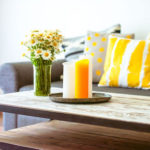
There are hundreds of different styles and aesthetics to choose from regarding interior design. One of the most popular trends of the last decade is the minimalist aesthetic. Part of what makes minimalist interior design so appealing is the fact that versatility. No matter what your personal style or design preferences are, you can create a minimalistic appearance throughout your home. Another great thing about the minimalist aesthetic is that it’s easy to achieve. You don’t need to be a professional interior designer to make your home look chic and minimalist.
What is Minimalist Interior Design?
Minimalist interior design bares a lot of resemblance to modern interior design because it revolves around simplicity. A room must be uncluttered, cohesive, and neat for it to be minimalistic.
The minimalistic interior design uses open-plan designs, lots of natural light, and functional furniture. It comprises monochromatic colors and clean lines. Some colors may be used as accents using decorative vases or ornaments, but bright colors shouldn’t be too overbearing.
Many people choose to extend minimalism into other aspects of their lives. Stripping things down to the basics and living without an excessive number of belongings not only keeps your personal space uncluttered but also your mind. You can think of minimalism as the opposite of materialism. Instead of filling your home with lots of redundant accessories, you stick to the essentials only.
Elements of Minimalistic Interior Design
We’re already briefly mentioned the key aspects of minimalistic interior design. However, we wanted to summarise them into a short list so that you know exactly what you’re aiming for when converting your home into one of minimalism and simplicity.
The main minimalistic interior design elements include:
- Essentials only
- Open plan and light
- Neat and clean
- Monochromatic color palette (white, beige, grey, and mocha) with very few colorful accents
- Strong surfaces and clean lines
- Clutter-free
How to Achieve Minimalistic Interior Design
Whether you’re redesigning your bedroom, living room, kitchen, or even your garden, you can easily achieve a minimalistic look. If you want to transform your home into one that is minimalistic and simple, follow the four top tips below.
1. Declutter
Before you can even begin to think about the layout of your home or the monochromatic accessories that you’re going to buy, you need to declutter. Every minimalistic look begins with getting rid of unnecessary items.
Spend some time going through every room in your home and figuring out what you no longer use, want to, or need. Be staying with yourself and don’t be afraid to get rid of your belongings.
Avoid telling yourself that you’ll keep something “just in case” you need it in the future. If you haven’t used it in the last 12 months, it’s time to pass it on to somebody else!
2. Don’t Forget the Small Touches
Because minimalistic designs use very few accessories and furniture items, they carry a risk of looking lifeless. To prevent your home from looking and feeling uninviting, focus on the small touches.
Use ornaments and accessories to accentuate your interior design without taking away from the crisp, clean minimalistic appearance. You can include accents in every room. For example, you can add a touch of brass to your kitchen accessories or place a textured rug in the living room with some color and warmth.
3. Create Focal Points
Minimalistic interior design works best when you create key focal points in each room. Focal points break up the room and prevent it from looking boring or uncharacteristic.
You can create focal points using accent lighting, wall art, vases filled with colorful flowers, or ornaments. They add a little space to your interior design without taking away from its simplicity.
4. Keep Wall Art to a Minimum
Wall art can be a great way to add the finishing touches to your minimalistic interior design but it’s important not to go overboard with your artwork. Hanging too many things on the walls can make your rooms look cluttered, even if you’ve used minimal furniture and accents.
Keep your wall art to a maximum of two large pieces or between three and five small pieces of art. If you’re using multiple smaller pieces, consider getting matching or complementary art that you can place in a cluster on the main wall of each room. Using clusters of wall art will capture people’s attention without making the room look cluttered.
- How To Boost Your Confidence on a First Date - February 23, 2024
- 5 Must-Try Fashion Trends for 2024 - February 14, 2024
- 12 Must-Have Items for Your Daughter’s Gift Basket - November 28, 2023






